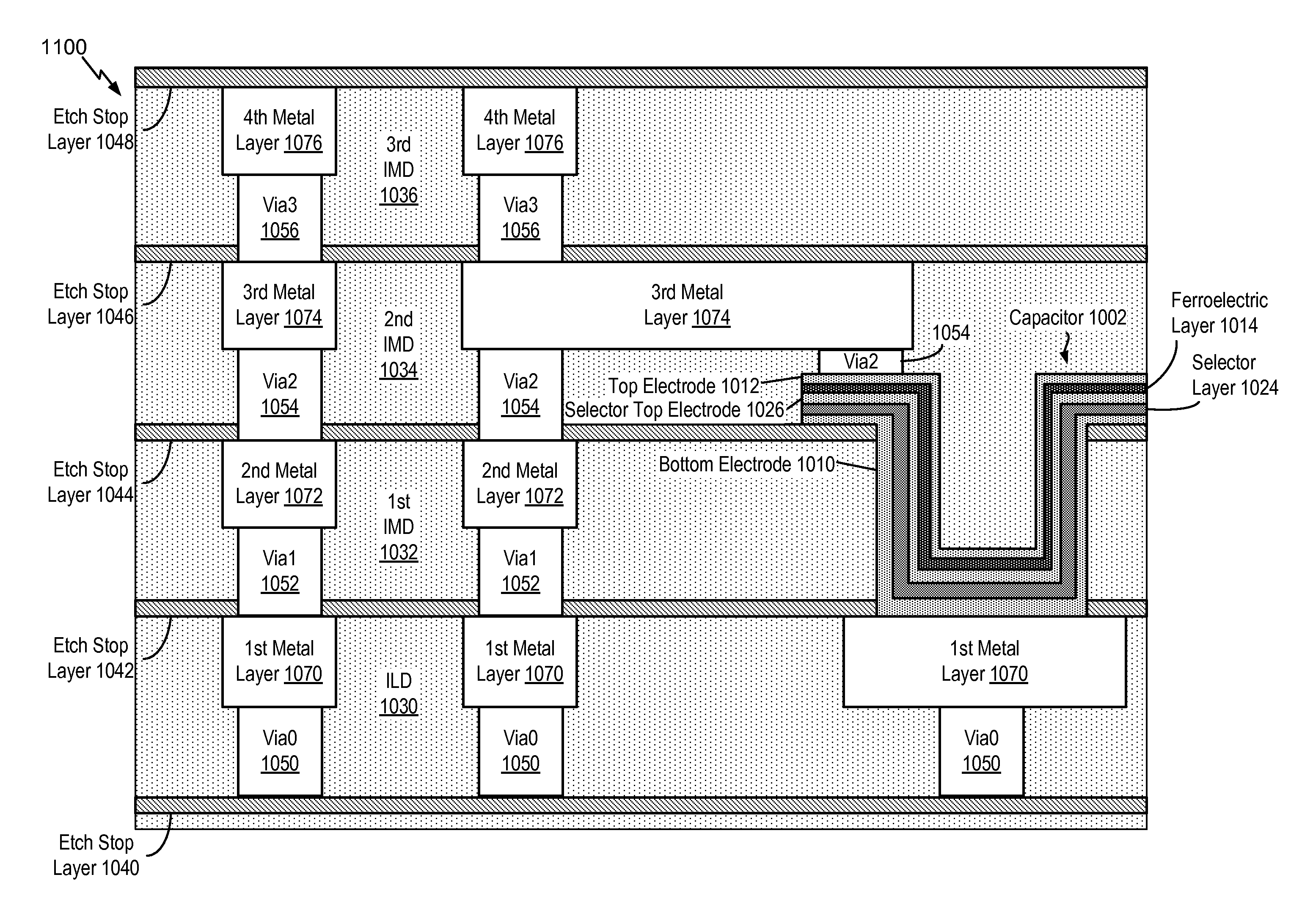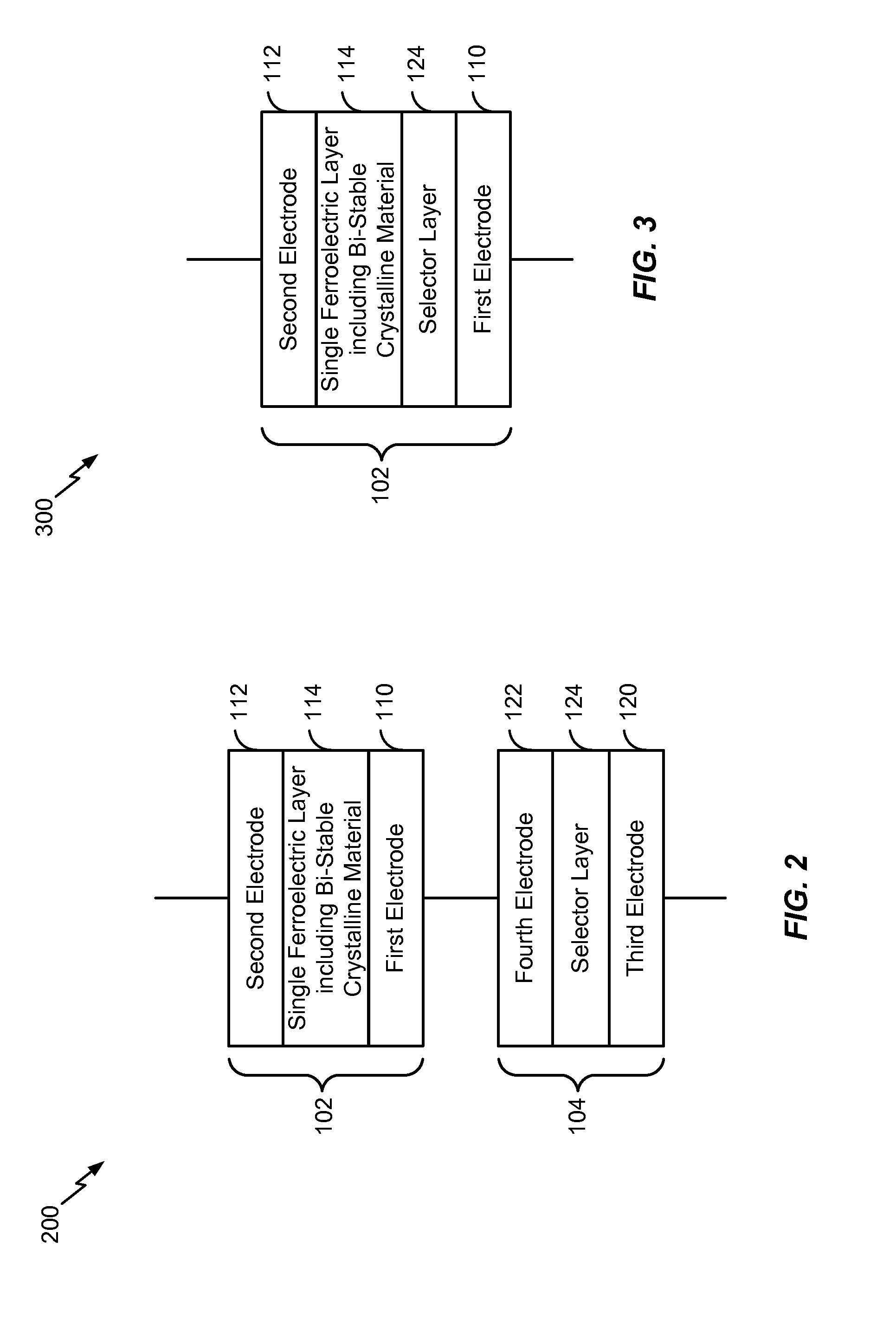Dynamic random access memory cell including a ferroelectric capacitor
a ferroelectric capacitor and random access technology, applied in capacitors, transistors, capacitors with voltage varied dielectrics, etc., can solve the problems of reducing the amount of charge stored by the electrodes, changing a stored logical value, and potentially falling below the retention time threshold. , to achieve the effect of reducing power consumption, reducing capacitor size, and reducing the size of the capacitor
- Summary
- Abstract
- Description
- Claims
- Application Information
AI Technical Summary
Benefits of technology
Problems solved by technology
Method used
Image
Examples
first embodiment
[0035]Referring to FIG. 1, a dynamic random-access memory (DRAM) cell 100 is shown. The DRAM cell 100 may include a capacitor 102 and a selector 104. In some embodiments, the selector 104 may be coupled in series with the capacitor 102, as further described with reference to FIGS. 2 and 3. In other embodiments, the selector 104 may be integrated within the capacitor 102, as further described with reference to FIGS. 4 and 5. In an alternate embodiment, the DRAM cell 100 may include a transistor coupled to the capacitor 102 instead of the selector 104. Multiple DRAM cells having a similar configuration to the DRAM cell 100 may be included in a memory array. In a particular embodiment, the multiple DRAM cells may be included in a cross-point DRAM array.
[0036]As shown in FIG. 1, the capacitor 102 may include a first electrode 110 (e.g., a bottom electrode), a second electrode 112 (e.g., a top electrode), and a single ferroelectric layer 114 disposed between the first electrode 110 and t...
second embodiment
[0052]Referring to FIG. 2, the DRAM cell of FIG. 1 is shown and designated 200. In the DRAM cell 200, the selector 104 is separate from (e.g., external to) the capacitor 102 and is coupled in series with the capacitor 102. The capacitor 102 is configured as described with reference to FIG. 1.
[0053]As illustrated in FIG. 2, the selector 104 may include a third electrode 120 (e.g., a selector bottom electrode), a fourth electrode 122 (e.g., a selector top electrode), and a selector layer 124 disposed between the third electrode 120 and the fourth electrode 122. The selector layer 124 may include a voltage-dependant resistor layer. As described with reference to FIG. 1, the selector layer 124 may function in a similar manner to a diode. The selector layer 124 (e.g., the voltage-dependent resistor layer) may be formed as a film layer and may correspond to an insulator at low voltages. In a particular embodiment, the insulating film may include platinum (Pt), tantalum oxide (TaOx), titan...
third embodiment
[0055]Referring to FIG. 3, the DRAM cell of FIG. 1 is shown and designated 300. In the DRAM cell 300, the selector 104 is integrated within the capacitor 102. The capacitor 102 is configured as described with reference to FIG. 1.
[0056]As illustrated in FIG. 3, the selector layer 124 may be disposed between the single ferroelectric layer 114 and the first electrode 110. In a particular embodiment, the selector layer 124 may be in contact with the single ferroelectric layer 114. In an alternate embodiment, an electrode (e.g., a selector top electrode) may be disposed between the selector layer 124 and the single ferroelectric layer 114.
[0057]The selector layer 124 may include a voltage-dependant resistor layer. As described with reference to FIG. 1, the selector layer 124 may exhibit diode-type (e.g., non-linear) I-V characteristics (in a forward bias conditions). The selector layer 124 (e.g., the voltage-dependent resistor layer) may be formed as a film layer and may correspond to an...
PUM
| Property | Measurement | Unit |
|---|---|---|
| feature sizes | aaaaa | aaaaa |
| thickness | aaaaa | aaaaa |
| thickness | aaaaa | aaaaa |
Abstract
Description
Claims
Application Information
 Login to View More
Login to View More - R&D
- Intellectual Property
- Life Sciences
- Materials
- Tech Scout
- Unparalleled Data Quality
- Higher Quality Content
- 60% Fewer Hallucinations
Browse by: Latest US Patents, China's latest patents, Technical Efficacy Thesaurus, Application Domain, Technology Topic, Popular Technical Reports.
© 2025 PatSnap. All rights reserved.Legal|Privacy policy|Modern Slavery Act Transparency Statement|Sitemap|About US| Contact US: help@patsnap.com



